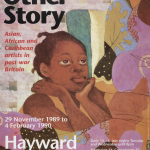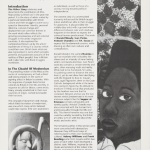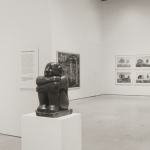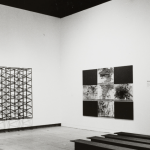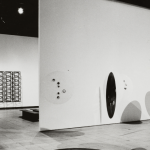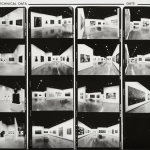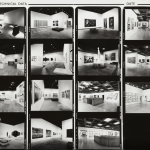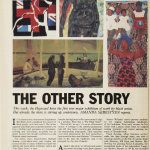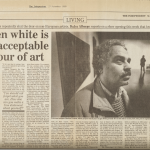By Alice Zheng
Since the 1970s, artists of color have debated about representation in museums and galleries, especially in Euro-American spaces. Art institutions have long been sites with political implications. In fact, “the first public museums opened amidst heated debates regarding democratic access to valuable collections,” (Herle). With this, there has been a surge of artists who demand representation in predominantly white institutions. Many of these artists interact with their work with art as political engagement. In addition to new work, the meanings of older works change as society’s thoughts on representation change.
Art institutions continue to be sites of recapturing, regenerating, or simply creating cultural meaning through objects. As spaces for “transitive, entangled, and often contested realities,” museums and galleries are also places for the discussion of changing social relations. In this project, I discuss a 1989 Hayward Gallery (London) exhibition called The Other Story: Afro-Asian Artists in Post-War Britain and examine the notions of solidarity and representation made by the curator, Rasheed Araeen.
The pivotal moments of change and representation of non-white artists within the art institution have been long fought for. In these cases, the decisions of representation are made indirectly by the art council of an institution in their choosing of the curator. As the curator is an exclusive authority, it is of great importance that The Other Story: Afro-Asian Artists in Post-War Britain was led by an independent artist and curator, Rasheed Araeen. In 1978, Rasheed Araeen proposed the exhibition to the Hayward Gallery Arts Council. With the focus of the exhibition on artists between 1946 through 1986, it was meant to redefine modernism including Afro-Asian artists. In his letter to the council, Araeen claimed that such an underrepresentation is “problematic and challenging…[these artists] expand the boundaries of modernism beyond its Eurocentric framework,” (Hayward Gallery). Araeen’s mission in focusing the work on modernism was to dismantle the notion that artists of Afro-Asian descent are only referred to in art history by their cultural traditions, when in fact, they have created their own modern history. To subvert such notions of being the “The Other” and “The Yesteryear,” Araeen curated an exhibition containing twenty-four artists while framing four sections within the span of 1946-1986. These four sections consisted of ‘In the Citadel of Modernism’; ‘Taking the Bull by the Horns’; ‘Confronting the System’; and ‘Recovering Cultural Metaphors’.
In analyzing the wall texts of these four sections as well as the placement of artists, I argue the extent to which Araeen and the Hayward Gallery makes this exhibition a documentation of solidarity between the Afro-Asian communities. Araeen, though not addressing with explicit emphasis on solidarity, labels the exhibition “Afro-Asian,” a term uncommon in 1989. Thus, this exhibition was not only an effort to expand the realm of modernism but also to allow the groups from the peripheries of art history to be grouped together and celebrated. Today, The Other Story: Afro-Asian in Post-War Britain is seen as a hallmark exhibition of 1989 presenting artists of color. Next to other 1989 shows like Magiciens de la Terre at the Centre Pompidou in Paris, and the third Bienal de La Habana, the three exhibitions raise questions of art, politics, and identity into question. My project addresses those differences and similarities in addressals.
In addition, I analyze how the 1989 media presented by the Hayward Gallery has depicted the exhibition to the public. Written by Anandi Ramamurthy under the Hayward Gallery in 1989, an exhibition guide was presented for the first opening of the show. Anandi Ramamurthy is currently a Senior Lecturer in Media at Sheffield Hallam University, located in the United Kingdom. Her research interests include analyzing race relations and postcoloniality in media and culture. I argue that this exhibition guide has trouble in conveying the work the artists presented as curator Rasheed Araeen intended to. His intentions for the celebration of Afro-Artists are diluted to artists finding their way in Britain.
This exhibition guide reveals that the presenters of media to the British audience and the curator’s intentions were not always aligned. Ramamurthy claims that artists are “united by a particular relationship with British culture and their struggle to carve out a space for themselves,” (Hayward Gallery). This statement conveys that the artists are not from Britain. It implies that the artists are seeking for an identity to tie with British culture and not expressing a dual-identity. Ramamurthy continues this introduction with the statement, “Identity, personal dilemma, cultural change and displacement are common themes in the work which often reflects the growing consciousness and anti-colonial struggles in the artists’ respective countries,” (Hayward Gallery). Most of these artists are born in Britain or live in Britain. This raises the questions of: what do we define as one’s ‘home country’? Is this country the place where the artist is culturally tied to, ethically tied to, or geographically tied to? The introduction does not make the distinctions of whether artists were born in Britain, living in Britain, or both.
Rasheed Araeen’s intentions for The Other Story: Afro-Asian in Post-War Britain were to provide a space for Afro-Asian artists to redefine modernism without Euro-American contexts being the driving force to their art. This exhibition “discusses the roots of the controversy in Britain’s imperialist attitudes to race, nationalism and internationalism, the exhibition’s contribution to the erosion of ethnic barriers in the art establishment and its role in opening up a cosmopolitan perspective on British diasporan art,” (Fischer). It is an acknowledgement of an eurocentric art history. Rasheed Araeen argues that Afro-Asian artists are not seeking reaffirmation from Euro-American spaces. Instead, they are reclaiming spaces and redefining modernism to represent those with Afro-Asian and diasporic identities.
Works Cited
Fischer, Jean. “The Other Story and the Past Imperfect – Tate Papers.” Tate, Tate, 2009, www.tate.org.uk/research/publications/tate-papers/no-12/the-other-story-and-the-past-imperfect.
Hayward Gallery. “The Other Story: Afro-Asian Artists in Post-War Britain – Google Arts & Culture.” Google, Google, 1989, artsandculture.google.com/exhibit/3wKiyZvGtKdOKA.
Herle, Anita. “MUSEUMS, POLITICS AND REPRESENTATION.” Journal of Museum Ethnography, no. 9 (1997): 65-78.
